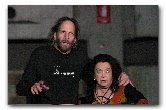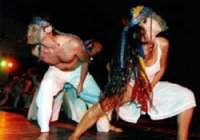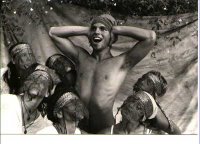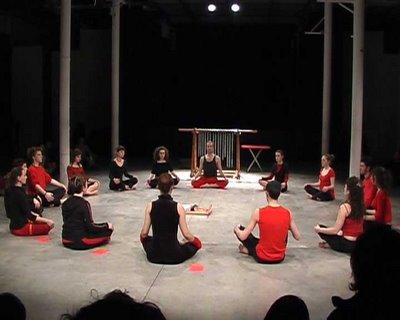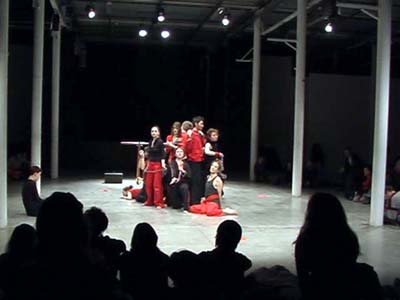The Living Theatre: anarchic heritage. The Seven Meditations on Political Sadomasochism thirty years later in Turin. Seven meditations Il Living Theatre: un'eredità anarchica. Le Sette Meditazioni sul Sadomasochismo politico trent'anni dopo a Torino. (28 febbraio/11 March 2006)
"The form of government that is more suited to the artist is the absence of any government" (Oscar Wilde)
We have just concluded in Turin and in some cities Italian recalled the day-long workshop, twenty years after the death of Julian Beck, the extraordinary experience of this theater group, which now boasts more than half a century old, and already you can see some interesting examples of contamination. On the other hand, the metaphor of the theater and ideas that sprout from tiny seeds scattered revolution with perseverance and determination has always been a theme dear to the actors and the Living is probably the lesson more real and lasting ..
strange and moving today to review this show designed in a completely different historical and political context, that of the seventies, when the stars of this legendary American theater group dedicated themselves body and soul to a political theater and research that had led them to abandon the conventional theatrical venues for their shows reach the common people, that is not usually in conventional theatrical venues: a theatrical experience that would make school and who has left a legacy unique and vital years later.
Living Theatre and anarchy Theatre of Living in the Seventies, was a scene of "trench" where you will experience the impression that "asking the impossible" was not only obvious but had to. These were the years of experience-break of the French May, who had inspired one of the most famous pieces of the group: "Paradise Now." Their research, begun in the street, and continued in the ghettos, factories, newspapers and humble touches upon themes that are then converted into absolute and general categories: Power, Money, Love, War, Death, Property and generates an original way of working, which is closely linked to those days which consisted essentially of two phases: a strictly informational / politics and another tending to communicate awareness reached "sensitizing" as it was then, people on an uncomfortable reality, but not always accepted view, one of violence and death. The recipes were simple and absolutely crystal clear: love as a voluntary act and absolute and the theater-"wooden horse to take the city" - which would serve to undermine from within the institutions, the clichés, conventions: the thousand ill-disguised prisons daily. The goal: "Bella Non-Violent Anarchist Revolution", which was to follow a "free and harmonious life mentally, physically, sexually." Basically the people on the street Beck and Malina and their companions were trying to say that money is not important, that you might as well live without, because the existing would be sufficient for all, that there is no need to kill to work as an important leisure, you could live and work in their own self friendly cooperation, which would abolish the government, police, armies, property , prisons, and then consumerism, advertising, war, nationalism, all those values \u200b\u200band needs, which results from a social structure that produces hatred and unnecessary work.
The practice of "street theater", a conclusion consistent and necessary to a speech carried on with an almost messianic logic that the experience involves a total public and private sectors, the report, both as individuals and as a collective with the repressive apparatus with an attitude of blatant challenge, knowing that it meant suffering and blunt a backlash that manifested itself in boycotts bureaucratic, "beatings, arrests, prosecutions and convictions.
André Reszler in "Aesthetic Anarchist" in 1975, argued that the Living Theatre has three parallel objectives: the revolution through art, the Revolution through direct political action and anarchism as a lived experience. Living for the theater of action amounts to a meaningful political theater where you create a class consciousness, a political theater in which political life is put in opposition to the politics of death.
The experience of political theater has borrowed heavily from the teachings of Erwin Piscator, including Judith Malina was a student, but is refined mainly since 1963, after closing for "unavailability" of the local Fourteenth Street, where he held the representations of the group. In 1964 with "Mysteries and smaller pieces" Living is presented to the public with a revolutionary new text, the first attempt to "Free Theatre" collective work and without direction, the show is strongly characterized by anti-war themes and some members who do not share the cut given to the work, leaving the group. With the "Frankenstein" takes an overview of the history of mankind ottca under the violence of institutions. With "Antigone" and "Paradise Now" in 1968, the libertarian value becomes a unique feature of the group and a hallmark of their "action" stage. "
The matrix is \u200b\u200ban anarchist in a fragmented and eclectic from the beginning. Promulgation of the "Bella Non-Violent Anarchist Revolution" Judith Malina and Julian Beck incorporate the suggestions of solidarity and federal Kropotkin, Proudhon's dialectics, the pacifist and mystical anarchism of Tolstoy's works represent the American Paul Goodman, mixing them with the components present in the years Sixties radical groups in the U.S.: Eastern mysticism, Zen philosophy, the theories about the liberation of sexual energy by Wilhelm Reich.
The first contacts with anarcho-syndicalism is 1960, when members of the group participating in the collective of the IWW. After lengthy discussions the entire collective decides to officially join the association "wobbly", working as individuals in Job Branch, but as a group by subscribing to the policy initiatives of the association. From this moment becomes the Living and collective self-view of many members of the group experience and the practice has increased a great deal of anarcho-syndicalist group, giving a strong political motivation and the feeling states to be included in a global revolutionary project shared.
The "Seven Meditations on Political sadomasochism" "The Seven Meditations on Political sadomasochism" born in this context and are part of a broader project - "The Legacy of Cain" - a great cycle theater, designed as a constellation made up of hundreds of stars, "a constellation that shines in a town or village" getting his "double" and assuming, then, each time a different face. The pieces of the cycle, a hundred different performances by style, length and language (some lasted a few minutes, others several hours) were shown between 1970 and 1978. They were intended to show those people who have not, in general, the chance to go to the theater and culture for economic reasons. The intent was to create a participatory climate encourage people to rediscover itself and reinvent their identity and culture. The scenery, as usual, bare essential, the existing elements are exploited, the bodies themselves become props. The colors used for the costumes, red and black, referring to the anarchist symbol.
The theme, the relationship established between master and slave, or, more generally, between executioners and victims, between those who command and those who suffer: a report based on a sadomasochistic bond. The argument drew its inspiration from project of the same name by the Austrian writer Sacher-Masoch: all men are subject to the law of violence, used by those in power, but also accepted, almost with satisfaction by those who suffer. This violence manifests itself in various forms: the power of the state, loving relationship, money, property, war and militarism, the culture of death. The owner, envied by the slave, in his eyes is a role model, an example of wisdom, beauty, perfection. In the end, the saga of Masoch, the master kills the slave consent. The aim pursued by the Austrian writer is to understand and break free from this kind of abusive relationship starting from the understanding of the element of love-hate between people in the form of psycho-sexual violence.
as devised by the Living, "The Legacy of Cain" became a kind of psychodrama where spectators were expected to reach an awareness of their frustrations and find, then, though not necessarily, the ability to overcome them. The pieces will follow the themes of-Masoch, and the same framework of mutual interweaving between the various forms of repression, but are thought to be reformulated depending on the occasion, thus making each time a different representation that wants to reflect the contingent reality. It 's the case of "Oratory of support for a strike," represented in Reggio Emilia in favor of the factory workers who were made redundant. The best-known pieces of the cycle, in fact never officially closed, are: "Seven Meditations on Political sadomasochism," "You are public documents," "The Tower of money" represented, for the first time in Italy, the Venice Biennale 1975. At the last performance of "Tower of money", in Venice the show was interrupted for a few minutes, one of the actors addressing the audience said: "In Venice we found people who said that the Living is the worst thing that has been brought to the Biennale, but we also found people who understood our work, and wonderful people, brothers, and as we struggle against the state and exploitation to a free society, for Anarchy "
Take Thirty years later and not waste the experience today is very important and there are several positive signs in this direction that must be reported, beginning with the stubborn and courageous work of Gary Brackett, who with Cathy Marchand, has continued in recent years to "contaminated" with small seeds of awareness livinghiana the Italian theatrical scene, enabling labs for students where you take the proven techniques for years in the Living Theatre - Technical yoga, Zen meditation, bio-mechanics - especially reaffirming its belief that the play is first and foremost a "collective creation". Gary has worked since 1989 with the theater collective of Living, has enabled many theatrical experiences in Bologna, Bari, Rome, New York, Turin, developed a personal vision of the theater where the traditional job search techniques on the body, meditation and political theater adds a keen interest in the potential of computer and video techniques, as can be seen on his website - www.videoweekly.net - a sort of video-weekly newspaper on the web of politics and culture. "Who are the promoters of contemporary culture that should be confused by the conflict between everyday life and "play" newspaper to make sense the apparent senselessness of the world? "Asks Gary and again" after all the vicissitudes of the world happening right outside our windows. " On the video offered on the site titled "This week's this" the computer and TV are our windows overlooking a plaza / virtual theater that is the Web.
In the show staged in Turin, directed by Gary was primarily a work of philological reconstruction work, notwithstanding the obvious update to the current historical context, as well as an operation to appear on the strictly didactic method of working aged Living by who was able to depress the boys in exactly the size and atmosphere. Not Remember that the piece on "Seven Meditations", introduction to the 'legacy of Cain "was designed for students and people interested in the discipline of meditation and had as its goal to unify the minds to a higher energy level, collective.
I asked the young actors you can not find the part and dated as compared to calls placed applicants and highlighted the class struggle, rather than removed and outdated argument today, the writings of Malatesta, and anarchist ideals, and they said that they had discussed among themselves and that they had found the work surprisingly present, because the issues addressed in the meditations are unfortunately very true today as then, violence is an insidious and widespread practice, the wars continue to ravage the world, the power of money rule the life of the planet and the final question "What can we do to change?" is, alas, the beautiful News.
The show was brought in several public places in Pinerolo, Val di Susa, in the social centers of the Baroque and Asylum Busy, Espace Via Mantova, and everywhere the reception was very warm. In particular, in the Susa Valley, where recent events notav, lived in a collective and shared by the entire population Susa Valley, have certainly had a good game in a positive atmosphere and warm crare.
Recall that, on the sidelines of this experience, has opened a blog-http: / / cosapossiamofare.blogspot.com - which aims to continue and broaden the debate to the virtual web community. Never before, the Living, which has spanned more than half a century of our history and our political life, there appears to play a necessary and valuable object, shown in one dimension yet to be invented and discovered.
Turin, March 19, 2006
Carla Pagliero



